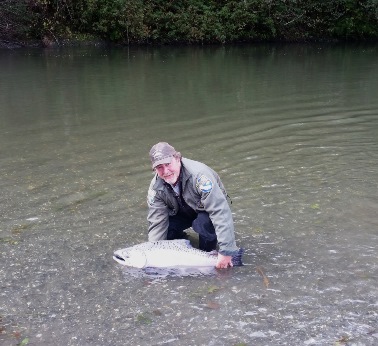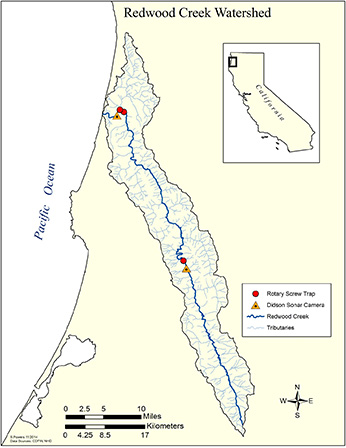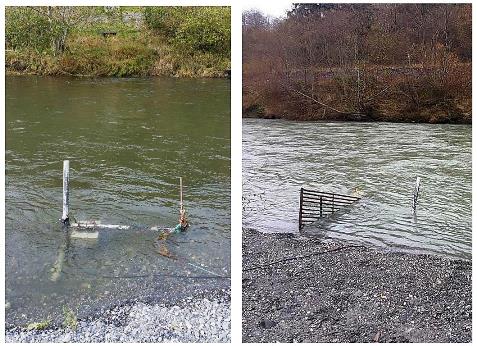(Redwood Creek, Humboldt County)
2016 Update
Species / Location
 Figure 1. CDFW scientist Michael D. Sparkman releasing an adult Chinook Salmon in Redwood Creek, Humboldt County, CA. CDFW Photo: S. Holt.
Figure 1. CDFW scientist Michael D. Sparkman releasing an adult Chinook Salmon in Redwood Creek, Humboldt County, CA. CDFW Photo: S. Holt.
 Figure 2. Map of Redwood Creek watershed with field sampling sites. (click/tap to enlarge)
Figure 2. Map of Redwood Creek watershed with field sampling sites. (click/tap to enlarge)
California Department of Fish and Wildlife (CDFW) monitored California Coastal Chinook Salmon (Oncorhynchus tshawytscha) returning to Redwood Creek, Humboldt County (Figures 1 and 2). This species is listed as “threatened” under the Endangered Species Act. Throughout the 2016/2017 monitoring period, CDFW also determined the abundance of adult Coho Salmon and steelhead returns.
Need for Drought Stressor Monitoring
Redwood Creek supports annual runs of native adult Chinook Salmon, Coho Salmon, steelhead, and Coastal Cutthroat Trout, and it is an intensively monitored stream for salmon and steelhead populations. The drought in 2013 restricted the migration of adult Chinook Salmon in Redwood Creek, and most of the salmon were not able to return to the middle and upper portions of the basin to spawn, as they do in normal water years (Figure 2).
Stressor Monitoring Efforts
CDFW estimated that adults having to spawn lower in the system resulted in a potential production loss of 440,000 individual smolts for the 2013 brood year. However, CDFW determined that 224,000 smolts survived migration to the Pacific Ocean to later become adults following this decrease in production (Sparkman et al., 2015). As a result, CDFW is working to determine how many of these smolts survived to adulthood and returned to Redwood Creek in 2016 (as three-year olds) and 2017 (as four-year olds). This information is critical in understanding how environmental variables, such as those associated with drought, impact salmon populations.
Findings
A sonar camera was installed and first operated when the mouth of Redwood Creek opened to the Pacific Ocean on October 14, 2016 (Figure 3). The sonar camera will operate from October 2016 through May 2017 to encompass adult migrations into Redwood Creek. The runs of adult Chinook Salmon, Coho Salmon, and steelhead are on-going, and therefore the estimates listed in Table 1 are considered preliminary and subject to change. The number of returning adult Chinook Salmon in 2016 (n = 2,354) is within the range (N = 1,600 – 3,400) that CDFW and Humboldt State University have reported in the recent past (Table 1). This return suggests that the drought in conjunction with reduced smolt production in 2013 did not severely limit the return of 3-year old adult Chinook Salmon in 2016. In addition, the return of 2,354 individuals suggests that ocean conditions in 2016 were not unfavorable for adult Chinook Salmon. The return of the four-year old component to the 2013 brood year will occur in the fall of 2017.
 Figure 3. Sonar camera (DIDSON) in lower Redwood Creek, Humboldt County, CA. Left Photo: The sonar camera is housed in the aluminum box attached to the left part of the sonar stand. CDFW photo M. Sparkman). Right Photo: The stand is partially submerged, and a fence is just downstream of the camera to prevent fish from passing behind the camera. CDFW photo S. Holt..
Figure 3. Sonar camera (DIDSON) in lower Redwood Creek, Humboldt County, CA. Left Photo: The sonar camera is housed in the aluminum box attached to the left part of the sonar stand. CDFW photo M. Sparkman). Right Photo: The stand is partially submerged, and a fence is just downstream of the camera to prevent fish from passing behind the camera. CDFW photo S. Holt..
Table 1. Preliminary estimates of adult Chinook Salmon , Coho Salmon, and steelhead returns to Redwood Creek, Humboldt County, CA., 10/14/16 - 12/8/16.
| |
Adult Returns (Preliminary) |
| Chinook Salmon |
2,354 |
| Coho Salmon |
304 |
| Steelhead |
418 |
Future Efforts
Adult Chinook Salmon return to Redwood Creek at ages 2 – 5 years, with most returning at ages 3 and 4 years. It is important that this study be continued through 2017 so that the returning 4-year olds can be counted. This additional information will help biologists understand how drought and reduced smolt production influenced returning adults. CDFW is committed to monitoring salmon populations to increase our understanding of how to better conserve and protect the species in light of drought and climate change.
Contact
CDFW
Humboldt State University California Cooperative Fish and Wildlife Research Unit